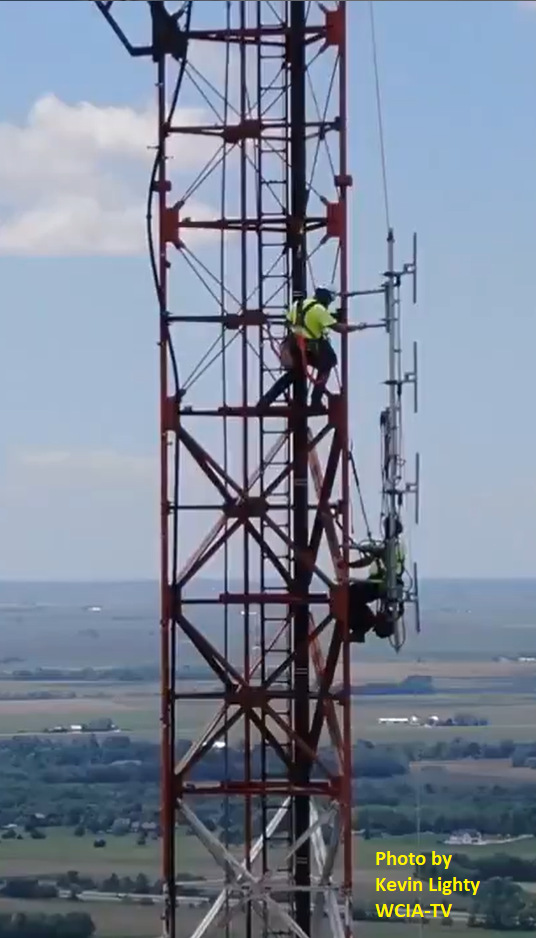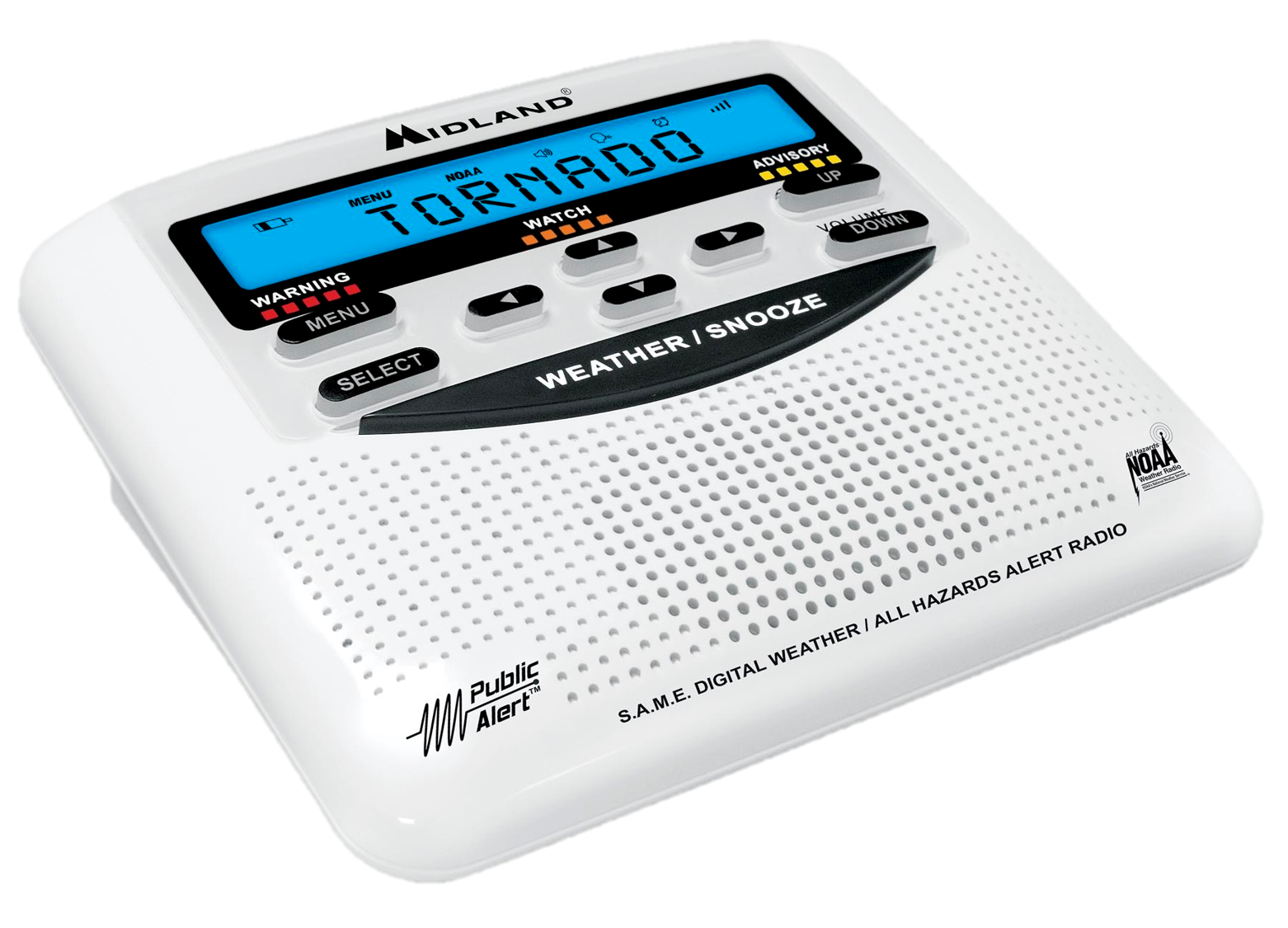Champaign, IL NOAA Weather Radio station WXJ-76 is Back in Service
The voice of the National Weather Service for east central Illinois is back on the air after a nearly 16 month hiatus. NOAA’s National Weather Service has relocated the transmitter and upgraded the broadcast antennas for NOAA Weather Radio station WXJ-76. Individuals in nine counties across east central Illinois, including the cities of Champaign-Urbana, Danville, and the University of Illinois, can once again receive a continuous broadcast of watches, warnings, forecasts and other hazard information on their NOAA Weather Radio.
Location and Signal Details
- The WCIA-TV broadcast tower, near Seymour, Illinois, is the new home of the WXJ-76 transmitter and antenna.

- The antenna is mounted at a height near 700 feet on the tower, which is 300 feet higher than the previous location. This should result in wider broadcast coverage in eastern and central Illinois than before.
- The power output is 1000 watts, generating a 40-45 mile radius listening area, covering around one-half million people in east central Illinois
- The broadcast originates at the NWS office in Lincoln, Illinois. The signal is sent from the NWS Lincoln office through cell towers to reception equipment at the tower site. WXJ-76 is one of the first NOAA Weather Radio sites in the country to use cellular phone service to relay broadcast signals (most weather radios rely on landline phone service).
- WXJ-76 operates on a radio frequency of 162.550 megahertz – or Channel 7 on most brands of weather alert radios.
- Listening to this station requires a specialized VHF radio receiver or scanner capable of receiving FM channels within the radio frequency range of 162.400 through 162.550 megahertz, known as the weather band. A standard FM or AM receiver will not be adequate.
Timeline of Weather Radio WXJ-76 Service and Extended Outage
- December 1, 1977: WXJ-76 begins broadcasting weather information from the NWS Springfield, IL office. It is only one of three 1,000 watt weather radio stations in central Illinois at the time.
- September 27, 1995: Broadcasts for WXJ-76 are transferred from NWS Springfield, IL to the new NWS office in Lincoln, IL.
- December 1998-February 1999: Automated weather radio broadcasts with computerized voices are phased in for WXJ-76.
- Summer-Fall 2019: NOAA and NWS Lincoln electronics staff begin a search for a new tower location for WXJ-76.
- Intermittent broadcast outages are occurring due to a suspected problem with the coaxial cable, which runs from the transmitter to the antenna. The coax cable had been replaced/repaired a few times since 2015, prompting the search for a new location.
- Late December 2019: Lease negotiations at a prospective new tower location in the vicinity of Champaign, IL are ended by the tower owner. NOAA and NWS Lincoln electronics staff begin the search for a new tower location in early 2020.
- WXJ-76 continues to broadcast from the previous tower site, but with a degraded signal.
- February 20, 2020: WXJ-76 officially goes off the air when the damaged coaxial cable is disconnected from the transmitter, and due to the previous tower lease being terminated about six weeks prior.
- Spring 2020: Amid the Covid-19 pandemic, lease negotiations begin with another prospective tower site in the vicinity of Champaign, IL.
- Late summer 2020: Lease negotiations are put on hold by the new tower site owner.
- December 2020: Lease negotiations are ended by the new tower site owner and the search for another site begins for the third time by NOAA and NWS.
- WCIA-TV / Nexstar Broadcasting expresses interest in being able to help with tower space for WXJ-76.
- March 10, 2021: A lease is signed between NOAA and Nexstar Broadcasting to use tower space at WCIA-TV for WXJ-76 broadcasts.
- April 9, 2021: A structural analysis of the WCIA-TV tower is completed and the lease between NOAA and Nexstar Broadcasting is executed.
- May 24-28, 2021: Electronics technicians and tower climbers install the transmitter, antenna, cables and data reception equipment at the WCIA-TV tower.
- May 28, 2021: NOAA Weather Radio broadcasting resumes on WXJ-76
Weather Radio, NOAA and NWS Information
- NOAA Weather Radio is one of the most reliable ways to stay informed about hazardous weather. It can provide you and your
 family with timely information so you can take action to stay safe. For information about NOAA Weather Radio receivers, go to our web page at: https://www.weather.gov/nwr/nwr_receivers
family with timely information so you can take action to stay safe. For information about NOAA Weather Radio receivers, go to our web page at: https://www.weather.gov/nwr/nwr_receivers
- NOAA Weather Radio with a backup power source is an excellent way to receive instant access to hazardous weather information, however, it’s important to have multiple sources to get weather warnings, including weather.gov, local TV and radio stations or download one of the many weather apps available.
- Most smart phone users receive Tornado Warnings and Flash Flood Warnings from the National Weather Service through the Wireless Emergency Alerts technology provided by nearly all cell phone providers. This feature is enabled on most cellular devices, with no setup or software to download. The emergency messages are broadcast through cell towers at no cost to the consumer.
- Residents of Champaign County, Illinois can also sign-up for AlertSense, which can relay emergency alerts and weather warnings via text message to cell phones or email to any email address. These alerts are provided free of charge, however standard text messaging rates and other charges may apply. To sign-up, go to: http://www.champaigncountyema.org/
- Other locations in east central Illinois may provide similar services. Check with your county Emergency Management Agency (EMA) for details.
- The NOAA Weather Radio network consists of 1,032 stations across the country and broadcasts official National Weather Service warnings, watches, forecasts and other hazard information 24 hours a day, 7 days a week. During an emergency, forecasters interrupt routine broadcasts to provide information about a potentially hazardous situation. The broadcasts are delivered in an automated voice.
- NOAA/National Weather Service’s Central IL Forecast Office, located in Lincoln, IL, is the primary source of weather data, forecasts and warnings for about 2 million people in central, eastern and southeastern Illinois (35 counties). Join us in social media on Facebook and Twitter.
- NOAA’s National Weather Service operates the most advanced weather and flood warning and forecast system in the world, helping to protect lives and property and enhance the national economy. Working with partners, NOAA’s National Weather Service is building a Weather-Ready Nation to support community resilience in the face of increasing vulnerability to extreme weather.


 family with timely information so you can take action to stay safe. For information about NOAA Weather Radio receivers, go to our web page at: https://www.weather.gov/nwr/nwr_receivers
family with timely information so you can take action to stay safe. For information about NOAA Weather Radio receivers, go to our web page at: https://www.weather.gov/nwr/nwr_receivers